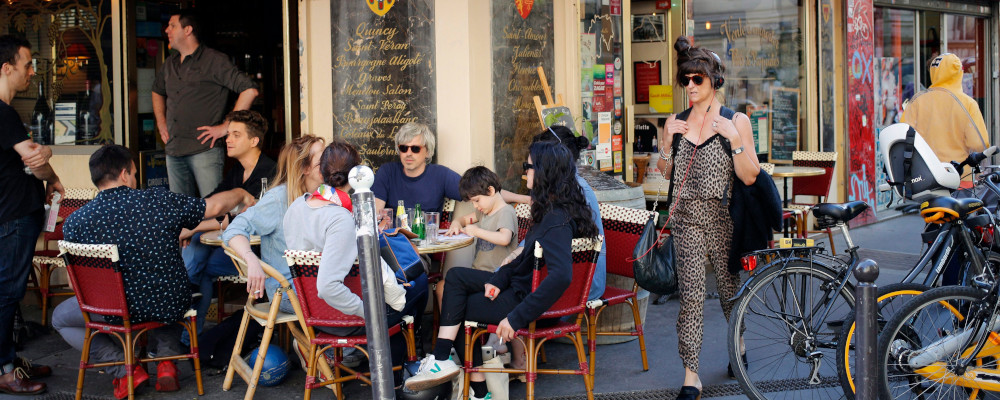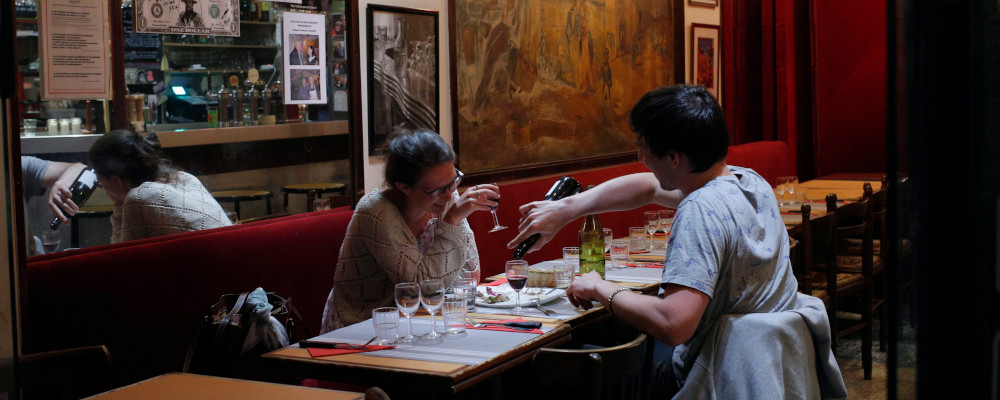“Come to me, you who whose stomach labours, and I will restore you,” wrote Monsieur Boulanger in 1765 on the sign outside the shop in Paris where he sold soup. This is, according to Prosper Montagné’s New Larousse Gastronomique (1960) considered to be the origin of the word restaurant and the modern definition of a place where a menu of diverse foods (and wines) are sold to the public in the same place that that they are consumed.
Montagné’s entry for restaurants quickly becomes a catalogue of renowned 19th-century Parisian establishments and a list of over 60 restaurants “of bygone days,” some of which have been closed for more than a hundred years. The history of restaurants, the book argues convincingly, is the modern history of the city, and there can be no doubt that Parisians take dining out seriously.
All of that cultural capital weighed heavily on me last week when my wife and I spent a few days in the French metropolis to visit our son, who is spending a semester there on a university exchange, and to eat and drink our way into some further understanding of the glories of the French culinary civilizing mission. We did well by it, and five of the places we dined in are listed below as recommendations to anyone who is lucky enough to find themselves hungry in the City of Light.

The word bistro, or bistro, is a term of art without a strict definition. By my reckoning, the five restaurants below qualify as bistros in that they are more casual than a formal restaurant, but offer a more structured experience than a café. I’ve included an interesting dish in each, all starters. All of the establishments also have classic bistro fare like steak frites, beef tartar, and some permutation of the greatest hits of French cuisine in the Parisian spirit of if it ain’t broke, don’t fix it.
Les Bacchantes
Where: Near the Palais Garnier Opera, 21 rue de Caumartin
What: A cozy and down-home bistro serving the classics
Why: Onion soup
The Bacchae were the mythical female followers of Dionysus, but this restaurant seems to take its name from a 1950s French movie whose poster is hung in the narrow and tightly packed dining room. It advertises that the film features 100 of the most beautiful women (in France, one presumes). What is unquestionably most beautiful about Les Bacchantes is the onion soup, served in a shallow bowl with a slice of broiled Gruyere on sourdough toast. I don’t know how many onions were cooked down, or which Cognac or spirit was splashed onto them to make the super-concentrated broth for this Platonic ideal of French onion soup, but I imagine it was an awful lot. It paired very nicely with a glass of rustic Sauvignon Blanc from Valençay and began the first meal we had in the city, foreshadowing more delicious and restorative things ahead.
Au Bon Coin
Where: Latin Quarter, 21 rue de la Collégiale
What: Small neighbourhood bistro with giant portions
Why: Snails with brioche
Established in 1904, it’s fun to think that this L-shaped bistro on a quiet residential corner has been dishing out snails for well over a century. While I don’t recall seeing frog legs on a menu while we were in Paris, traditional escargots were very much au courant in all their garlic, butter, and parsley glory. The version at Au Bon Coin has them out of their shells (no equipment necessary) and swimming in their sauce on a bed of soft bread. They pair very well with a glass of Champagne.
Chez L’Ami Jean
Where: Between the Eiffel Tower and Les Invalides: 27 rue Malar
What: Packed tight Basque bistro with haute cuisine aspirations
Why: Soup de maman Philomène
Established in 1930, L’Ami Jean is so small and so packed with a mix of locals and tourists that the servers have to slide the tables out so diners can sit against the walls. L’Ami Jean has a chef who is doing interesting things to the classics. The restaurant is lively and the service is quick, animated, and a bit brusque. Rushed for an order, we asked for the soup de maman without knowing what it was. We thought perhaps it would be a light starter. We were wrong: it’s a cheese soup made from a Parmesan broth, and we savoured every spoonful with a fruity Vermentino from the Languedoc.

Willi’s Wine Bar
Where: Behind the Palais-Royal: 13 rue de Petits-Champs
What: Anglo-Gallic collaboration with a storied wino history
Why: Ça dépend (probably foie gras and Champagne)
Willi’s Wine Bar was opened in 1980 by Mark Williamson, a young Englishman with a fondness for French wine and food, and it continues to attract discriminating winos with its interesting and extremely reasonably priced wine list. The food, as one would expect, is simple but elegant, as are the two attractive rooms. A torchon of goose foie gras comes with an icing of deep yellow fat and a glass of grower Champagne to cut it and cleanse the palate, in preparation for a ten-year-old Gigondas pulled from their extensive cellar.
La Charrette
Where: Left Bank off of Saint Germain: 17 rue des Beaux-Arts
What: Local hangout in the gallery district by the art school
Why: Crôque Monsieur with truffles
We found most of the restaurants we ate at in Paris by a combination of recommendations by friends or mentions by food and wine writers we trust, but La Charrette came to us purely by happy accident when we got lost looking for our son’s school, Science Po. We walked by it while it was still shut in the morning, but the simple and short menu appealed to us. When the three of us returned at lunchtime, we claimed the last table in the small but high-ceilinged room, rubbing elbows with who we imagined were employees of all the nearby galleries or professors at L’École nationale supérieure dex Beaux-Arts from around the corner. The special of the day was the mother of all grilled cheese sandwiches: a crôque monsieur whose filling of Gruyère, béchamel, and ham was seasoned with flecks of black truffle. Accompanied by a small green salad with a Dijon mustard vinaigrette and a glass of simple white wine from the Mâconnais in Burgundy, I tried to gather some self-control and ate mine with a knife and fork, bien sûr.
Recommended for You

Mark Carney’s Ottawa wants to plan prosperity. Alberta would rather create it

Alberta already tried Carney-style budgeting—it backfired

‘We have this incredible gift’: Why Canadian LNG is a ‘multi-billion dollar’ resource and key to global security

How Canada built, then broke, the world’s best immigration system




